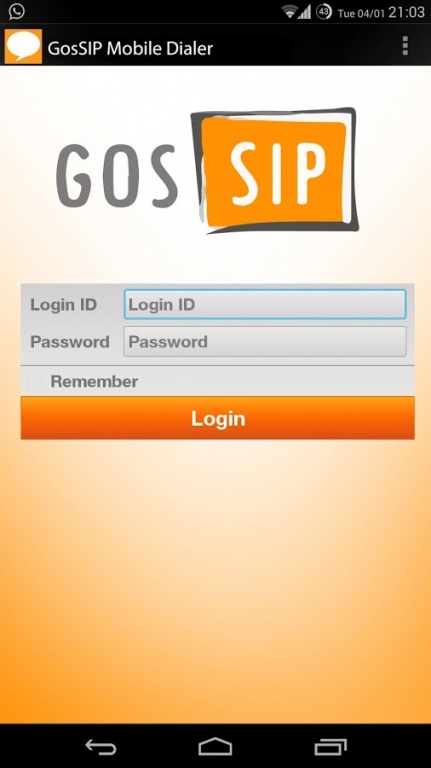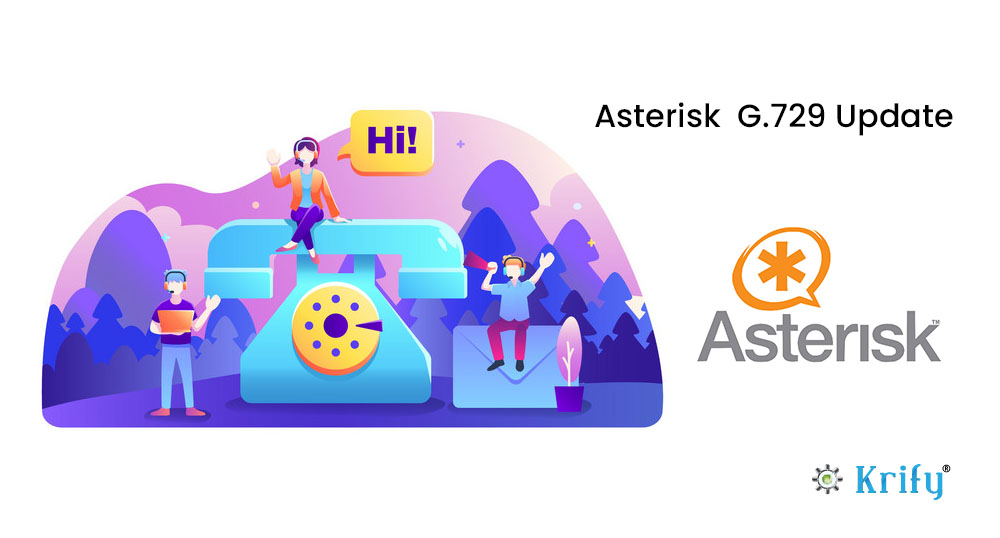G.729B is an extension of G.729 speech codec. G.729 is an ITU-T recommendation and it has been designed to achieve a reduction in the transmitted bit rate in a way that silent periods of human speech has been exploited. This speech codec codes speech and audio signals that are used in multimedia applications at 8 kbps. The g729 codec is a low bandwidth/high quality codec that’s available as an in-app purchase in Groundwire It can be found in SettingsAdd onsG.729. Acrobits Softphone & Groundwire Tickets.
G.729 is an ITU-T standard compression algorithm for audio data that compresses digital voice in packets of 10 ms duration. Its official name is Coding of speech at 8 kbps using conjugate-structure algebraic-code-excited linear prediction (CS-ACELP).
- Dialplate voip softphone. Dialplate is the best solution for attendant and call center operators, but also usable as a normal voip software phone, call management, transfer, hold, one-click calls and several other functions are optimized for these uses. The availability of advanced codecs such as the G729 allows their.
- Test codecs Test with all the codecs g711u, g729 and GSM. Sometimes the issues with the audio can be related with the codecs in use, either because the codec we are using is consuming too much bandwidth for our connection, there is also a chance the device we are using is not supporting this codec very well or it works better with a different one.
- Hii need any softphone which supports G729a not G729. I have searched but could not get.do u suggest any free softphone which supports G 729a codec?can u help m.
It is the lowest bit rate ITU-T standard with toll quality, offering opportunities for significant increases in bandwidth utilization in existing telephony and wireless applications. G.729 offers high quality, robust speech performance at the price of complexity at a low bit rate (8 kbps).
It requires 10 ms input frames and generates frames of 80 bits in length. Each of these generated 80 bit frames contains linear prediction factors, excitation code book indices, and gain parameters used by the decoder to reproduce speech. With the G.729 coder processing signals in 10 ms frames and a 5 ms look-ahead, the total algorithmic delay is 15 ms.
Use of this codec in a product requires licensing.
Due to its low bandwidth requirements, G.729 is commonly used by various VoIP applications. To provide more benefits the codec has been extended with various features, designated at G.729A and G.729B.
However, DTMF tones, Fax transmissions and high-quality audio cannot be transported with this algorithm.
Applications
- Digital telephony VoIP, Voice over ATM, Voice over Frame Relay, wireless, satellite, cable
- Videoconferencing, teleconferencing
- Multimedia, e.g., Digital Simultaneous Voice and Data
- Voicemail
- Media gateways
- Test and measurement equipment
- PDA/handset-hosted applications
Features
- MIPS/memory requirements for various platforms are available
- PSQM/PSQM+ values under different network conditions are also available
- Full and half duplex modes of operation
- Passes ITU test vectors
- Optimized for high performance on leading edge DSP architectures
- Multichannel implementation
- Multi-tasking environment compatible
- DAA interface using linear codec at 8.0 kHz sample rate
- Direct interface to 8.0 kHz PCM data stream (A-law or μ-law)
- North American/International Telephony (including caller ID) support available
- Simultaneous DTMF detector operation available - (less than 150 hits on Bellcore test tape typical)
- MF tone detectors, general purpose programmable tone detectors/generators available
- Data/Facsimile/Voice Distinction available
- Common compressed speech frame stream interface to support systems with multiple speech coders
- Dynamic speech coders selection if multiple speech codecs available
- Can be integrated with G.168 Echo Canceller and Tone Detection/Regeneration modules
- Multiple ports can be executed on a single DSP

Technology
- Encoded bandwidth: ~ 200-3400 Hz
- Standardized: ITU-T 1995
- Coding type: CS-ACELP (Conjugate-Structure Algebraic Code Excited Linear Prediction)
- Bit rate: 8 kbps
- Delay (ms):
- Frame size: 10
- Look-ahead: 5
- Quality: Toll
- Complexity:
- MIPS: 20-25
- RAM (words): < 4 K
Summary for G729 codec
| Algorithm | Sample Rate | Bit rate | Bits per sample | Latency | CBR | VBR | Stereo | Multi - channel |
|---|---|---|---|---|---|---|---|---|
| CS-ACELP, Lossy | 8 kHz | 8 kbit/s | 13 bit | 15 ms | Yes | No | No | No |
G.729A
G.729A is a compatible extension of G.729 and it is a Conjugate-Structure Algebraic-Code-Excited Linear Prediction (CS-ACELP) speech compression algorithm defined in ITU-T G.729 Annex A. It requires less computational power than G.729. However, lower complexity results in reduced speech quality. It can be employed for VoIP or similar applications using multimedia, voice, and/or data.
Technology
- Encoded bandwidth: ~ 200-3400 Hz
- Standardized: ETSI 1999
- Coding type: CS-ACELP (Conjugate-Structure Algebraic Code Excited Linear Prediction)
- Bit rate: 8 kbps
- Delay (ms):
- Frame size: 10
- Look-ahead: 5
- Quality: Toll
- Complexity:
- MIPS: 10
- RAM (words): 2 K
Features
- Compliant with G.729, Annex A, Annex B specifications
- Full and half duplex modes to operate
- Passes ITU test vectors
- Optimized for high performance on leading edge DSP architectures
- Multichannel implementation
- Multi-tasking environment compatible
- Common compressed speech frame stream to support systems with multiple codecs
- Voice Activity Detection and Comfort Noise Generation
Applications
- Digital satellite systems
- Voice/Fax/Data relay systems
- Multimedia products
- DCME, PSTN, ISDN
- Voice store and forward
- Video phones

G.729B

G.729B is an extension of G.729 speech codec. G.729 is an ITU-T recommendation and it has been designed to achieve a reduction in the transmitted bit rate in a way that silent periods of human speech has been exploited.
This speech codec codes speech and audio signals that are used in multimedia applications at 8 kbps. It employs Conjugate-Structure Algebraic-Code Excited Linear Prediction (CS-ACELP).
G.729B enables VAD (Voice Activity Detection). It is useful to detect voice activity in the signal. DTX (Discontinuous Transmission) module is also included to increase the overall efficiency.
(DTX is a method that allows momentarily to power-down or mute the telephone if there is no voice input.)
CNG (Comfort Noise Generation) is also included in this process by using 2 byte SID (Silence Insertion Descriptor). It is necessary because speakers may think that the link has been cut if it goes quite in case of no speech. In these cases CNG ensures that an analog hiss is simulated to make the receiver sure that the link is active.

Technology
- Standardized: ITU-T 1996
- Coding type: CS-ACELP (Conjugate-Structure Algebraic Code Excited Linear Prediction)
- Bit rate: <= 8 kbps
Softphone With G729 Codec Free Download
Features
- Full duplex and half duplex mode of operation
- Multiple channel compatibility
- All ITU-T test vectors are bit exact compatible
- Common compressed speech frame stream to support systems with multiple codecs
- VAD and CNG compatible
- Seamless integration with RTP/RTCP, DTMF, VAD and jitter management
Applications
- Digital satellite systems
- Voice/Fax/Data relay systems
- Multimedia products
- DCME, PSTN, ISDN
- Voice store and forward
- Video phones
Related Pages
IP Office Softphone - Codec selection
Softphone With G729 Codec
IP Office Softphone - Codec selection
IPO 9.0.4:
I have a collague who sits in Canada. Because his internet connection isn't the best we thought to use only codec g729 for his softphone (where the 9608 sets here in Austria use g711).
Nothing easier than that, I thought and tried to set the codec for the Softphone. But softphone doesn't use a defined extension (e.g. extension 100 for user 100 as normal h323 phones do), IP Office creates a temorary one on login, which will be gone after softphone logs out. It isn't possible to set codecs there anyway (everything is greyed out). I think in earlier days softphone used defined extensions, but anyway...
To get this working (Softphone using g729, 9608s using g711) I thought to set system default to g729 as first choice and at each phone's extension g711 as sole choice. I guess this would work but I don't like the solution very much (Changing the norm every time (new phone) instead of the exception).
Does anybody have an idea to solve this better? Is there somewhere a (hidden) setting to set a specific codec for softphones only?
Thanks in advance for your suggestions.
Markus